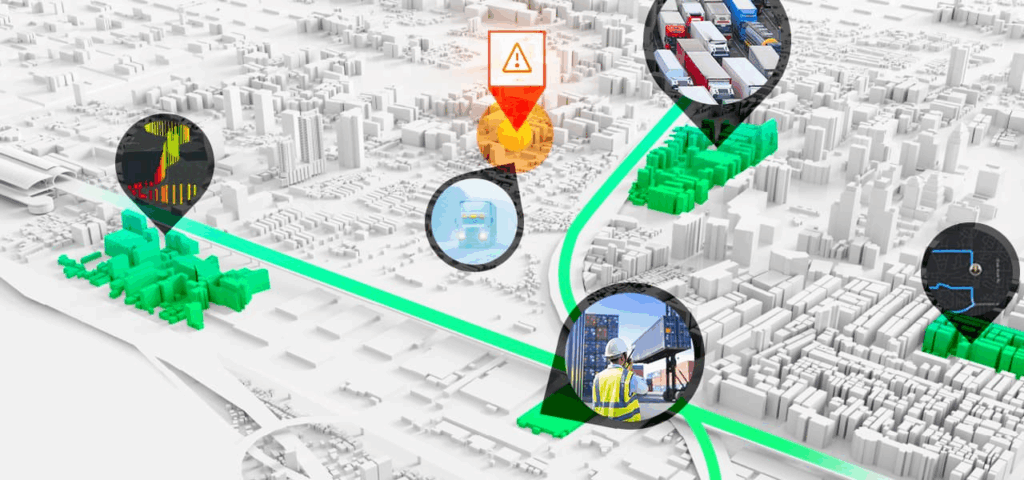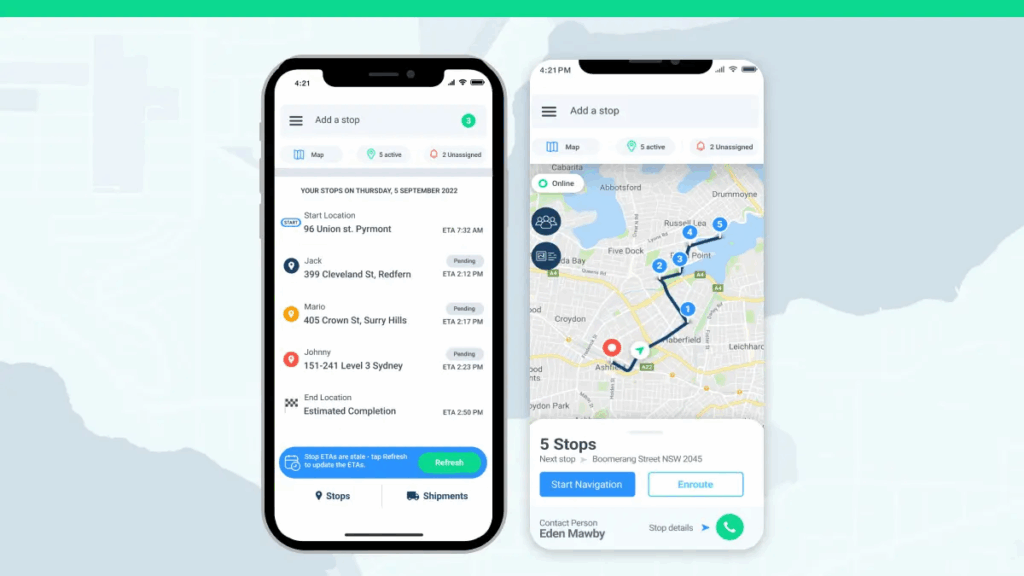El papel del seguimiento en tiempo real en las herramientas de visibilidad logística para el comercio electrónico
Por qué el seguimiento en tiempo real es importante para el comercio electrónico
Seguimiento en tiempo real en herramientas de visibilidad logística para el cumplimiento del comercio electrónico ya no es opcional. Los clientes esperan saber dónde están sus pedidos y cuándo llegarán. Para los minoristas en línea, ofrecer esta transparencia es fundamental. Sin ella, los retrasos, las entregas fallidas y los clientes insatisfechos pueden dañar rápidamente la confianza.
El comercio electrónico crece rápidamente y la competencia es dura. Las marcas que invierten en el seguimiento en tiempo real pueden destacar ofreciendo una mejor comunicación, una resolución de problemas más rápida y una experiencia de cumplimiento más fluida. Esto crea un ciclo de mayor fidelidad de los clientes y más ventas repetidas.

Evolución de las herramientas de visibilidad logística
De la actualización básica a la transparencia total
Los sistemas de seguimiento anteriores eran limitados. Los clientes sólo veían cuándo se dejaba un paquete en un almacén y cuándo se entregaba. No había información sobre retrasos, controles aduaneros o cambios de ruta. Esa falta de visibilidad causaba frustración y obligaba a los clientes a ponerse en contacto con el servicio de atención al cliente.
Las herramientas modernas de visibilidad logística proporcionan ahora actualizaciones continuas en cada etapa. Los paquetes pueden escanearse en varios puntos de control, y la tecnología GPS proporciona datos precisos sobre su ubicación. Con esta evolución, las empresas pueden compartir actualizaciones en directo con los clientes en lugar de vagas estimaciones.
Integración con sistemas de distribución
Las herramientas actuales no son autónomas. Se integran directamente con los sistemas de gestión de pedidos, las plataformas de los transportistas y las aplicaciones de los clientes. Esta integración permite ofrecer una experiencia sin fisuras: los clientes ven las actualizaciones en tiempo real, las empresas pueden controlar las excepciones y los transportistas pueden coordinarse mejor.
Principales ventajas del seguimiento en tiempo real
1. Mayor satisfacción del cliente
Los clientes quieren sentir que controlan sus pedidos. El seguimiento en tiempo real les asegura que su paquete está en camino. Cuando se producen retrasos, las actualizaciones claras ayudan a reducir la frustración. La transparencia genera confianza, y la confianza fideliza.
2. Mejora de la eficacia operativa
Para las empresas, las herramientas de visibilidad potenciadas por el seguimiento en tiempo real ayudan a identificar los problemas antes de que se agraven. Si un paquete se atasca en tránsito, el personal puede intervenir rápidamente. Las alertas predictivas también ayudan a los almacenes y centros de distribución a ajustar los horarios con antelación.
3. Reducido Atención al cliente Costes

Los clientes llaman o envían correos electrónicos al servicio de asistencia sin actualizaciones en tiempo real para preguntar por sus pedidos. Cada consulta aumenta los costes. Al ofrecer un seguimiento detallado, las empresas reducen "¿Dónde está mi pedido??". Esto ahorra tiempo y dinero.
4. Datos para decisiones más inteligentes
Los datos en tiempo real no sólo sirven para rastrear paquetes individuales. Con el tiempo, crean una potente base de datos. Las empresas pueden analizar los plazos de entrega, el rendimiento de los transportistas y los patrones regionales. Estos datos ayudan a perfeccionar las estrategias logísticas y a mejorar la velocidad de cumplimiento.
Cómo funciona el seguimiento en tiempo real
GPS y tecnología IoT
El seguimiento en tiempo real depende de dispositivos GPS y sensores de Internet de las Cosas (IoT). Camiones, contenedores e incluso paquetes individuales pueden equiparse con dispositivos que envían actualizaciones de localización en directo. Esto permite a las empresas conocer la posición exacta de las mercancías, tanto si se desplazan por una ciudad como por un océano.
Plataformas en la nube
La mayoría de las herramientas de visibilidad logística funcionan en plataformas en la nube. Los datos de transportistas, almacenes y sensores fluyen hacia un panel central. Desde allí, minoristas y clientes pueden acceder a actualizaciones en tiempo real desde sus ordenadores o dispositivos móviles.
Análisis predictivo
Más allá de las actualizaciones de ubicación, los sistemas avanzados utilizan análisis predictivos. Calculan las horas de llegada en función del tráfico, el tiempo o los trámites aduaneros. De este modo, el seguimiento deja de ser reactivo y se convierte en proactivo, ofreciendo a los clientes estimaciones de entrega precisas.
Casos prácticos en la gestión del comercio electrónico

Transparencia de los pedidos para los clientes
Cuando los clientes compran por Internet, quieren estar seguros de que su pedido llegará. El seguimiento en tiempo real proporciona actualizaciones de estado en vivo, como "listo para entrega" o "llega mañana". Esto reduce la ansiedad y mejora la experiencia de compra.
Gestión de excepciones
A veces, las entregas se retrasan debido al tráfico, las condiciones meteorológicas o los errores de ruta. Con visibilidad en tiempo real, las empresas pueden actuar con rapidez. Pueden informar a los clientes del retraso, redirigir los envíos o enviar productos de sustitución si es necesario.
Optimización de la entrega en la última milla
La última milla suele ser la fase más cara y complicada. El seguimiento en tiempo real ayuda a optimizar esta fase proporcionando a los conductores rutas actualizadas y a los clientes ventanas de entrega más estrechas. Esto reduce los intentos de entrega fallidos y mejora la eficiencia.
Internacional Cumplimiento
Para el comercio electrónico transfronterizo, la logística es aún más compleja. Los controles aduaneros, los múltiples transportistas y las diferentes normativas crean incertidumbre. Las herramientas de seguimiento en tiempo real conectan estos puntos para crear una cadena de visibilidad fluida, garantizando que los clientes en el extranjero reciban actualizaciones claras.
Impacto en la confianza y fidelidad de los clientes

El éxito del comercio electrónico depende en gran medida de la confianza de los clientes. Los compradores vuelven a las tiendas que ofrecen un servicio constante y una comunicación clara. El seguimiento en tiempo real es un factor fundamental para generar esa confianza.
Los clientes se sienten seguros incluso cuando se producen retrasos cuando una marca ofrece actualizaciones en directo. En lugar de frustración, aprecian la honestidad y el control. Esto se traduce en opiniones positivas, una reputación de marca más sólida y compras repetidas.
Retos de la aplicación del seguimiento en tiempo real
Inversión en tecnología
Añadir dispositivos GPS, IoT sensores y plataformas en la nube requiere una inversión. Para los pequeños minoristas, el coste puede parecer elevado al principio. Sin embargo, el ahorro a largo plazo derivado de la reducción de los costes de asistencia y la mejora de la eficiencia suele compensar el gasto inicial.
Integración de datos
Otro reto es conectar varios transportistas y sistemas. No todos los transportistas tienen la misma tecnología ni los mismos estándares. Las empresas necesitan herramientas que puedan unificar distintos flujos de datos en una sola plataforma.
Privacidad y seguridad
Compartir datos en tiempo real también plantea problemas de seguridad. Las empresas deben asegurarse de que los sistemas de seguimiento protegen la información sensible y cumplen la normativa. La encriptación robusta y el acceso controlado son esenciales.
Elegir la solución de seguimiento en tiempo real adecuada

Identificar las necesidades de la empresa
Cada comercio electrónico es diferente. Algunos pueden centrarse en pedidos nacionales, mientras que otros confían en el envío global. La solución adecuada depende del volumen de pedidos, las regiones de envío y las expectativas del cliente.
Evaluar las asociaciones con transportistas
No todos los transportistas ofrecen el mismo nivel de seguimiento. Las empresas deben trabajar con transportistas que ofrezcan una sólida integración de datos. Asociarse con transportistas fiables garantiza una mejor experiencia del cliente.
Busque plataformas escalables
A medida que las empresas crecen, las necesidades de seguimiento se amplían. Una buena herramienta de visibilidad debe ser escalable. Debe poder gestionar un mayor volumen de pedidos, más transportistas y funciones adicionales sin interrupciones.
Priorizar la facilidad de uso
Los mejores sistemas son intuitivos. El personal debe poder ver los cuadros de mando, analizar los datos y actuar sobre las alertas sin necesidad de profundos conocimientos técnicos. A los clientes también les debe resultar fácil hacer el seguimiento de los pedidos a través de sitios web o aplicaciones.
Tendencias futuras del seguimiento en tiempo real

IA y aprendizaje automático
La IA seguirá desempeñando un papel más importante. El aprendizaje automático puede predecir los problemas de entrega antes de que se produzcan, lo que permite a las empresas ajustar las rutas al instante.
Blockchain para la transparencia
Se está explorando la tecnología Blockchain para conseguir cadenas de suministro seguras y transparentes. Podría dar a los clientes una confianza aún mayor en la exactitud de los datos de seguimiento.
Integración de la sostenibilidad
El seguimiento en tiempo real también contribuirá a los objetivos de sostenibilidad. Al optimizar las rutas y reducir las entregas fallidas, las empresas reducen el consumo de combustible y las emisiones. Los clientes valoran cada vez más las prácticas ecológicas, lo que supone una ventaja competitiva.
Conclusión
Seguimiento en tiempo real en visibilidad logística Las herramientas para el cumplimiento del comercio electrónico han dejado de ser un lujo para convertirse en una necesidad. Mejoran la transparencia, la eficacia y la confianza, al tiempo que reducen los costes y los retrasos. Para las empresas, genera datos valiosos y operaciones más fluidas. A los clientes, les aporta confianza y tranquilidad.
A medida que crece la competencia, la capacidad de proporcionar información precisa y en tiempo real separará a las marcas de comercio electrónico de éxito de las que tienen dificultades. Invertir en estas herramientas no solo mejora el cumplimiento, sino que también fortalece las relaciones a largo plazo con los clientes.
Perspectivas del sector
noticias vía inbox
Nulla turp dis cursus. Integer liberos euismod pretium faucibua








